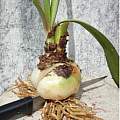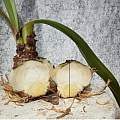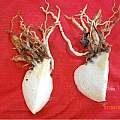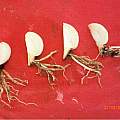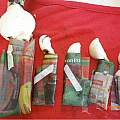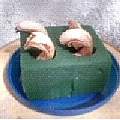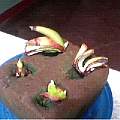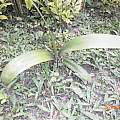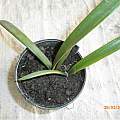Fabio Francisco Suarez
Reproduction of Hippeastrum bulbs by twin scaling.
This method allows the reproduction of bulbs of Albuca, Chasmanthe, Haemanthus, Hippeastrum, Hymenocallis, Lycoris, Narcissus, Nerine, Pancratium, Pyrolirion, Scilla, Sprekelia, Urceolina and Zephyranthes.
It can be used to multiply bulbs, especially hybrids and sterile hybrids, from which one can produce daughter bulbs genetically identical to the parent, while retaining a part of the parent bulbs which can later flower.
To propagate the bulb, lift it and clean off all the soil, being careful not to damage the roots, wash it very well with plenty of water, remove any dry scales (or flakes of tunic), and disinfect it by submerging it in water containing 1% sodium hypochlorite. To prepare the sodium hypochlorite solution, combine 3 parts water with one part 5% sodium hypochlorite. Leave the bulb in the 1% solution for 5 minutes; then remove it and rinse it with plenty of water.
Next use a knife to remove from the bulb a section as shown in photo 1 below. Make the cut parallel to the direction in which the leaves grow, extending the cut to include the basal plate from which the parent bulb’s roots come, so that the section also includes some root. Then divide the section you have removed lengthwise into two portions, as indicated by the black line in photo 2. Now divide each half in two again, producing 4 sections. Then divide each section between the scales, so that you are left with 8 slices each one with a basal plate, 4 with roots and 4 without roots. Then take the parent bulb and the slices, which are known as “twin scales” in the terminology of plant propagation, and keep them in the dark for 24 hours in order that the cuts will dry and scar over. True twin scale slices have just two scales, but the technique will work with slices that have more.
Wrap the roots of the scales and the remaining bulb in paper (photo 5), moistening it occasionally so that they do not dry out. After 24 hours, replant the parent bulb in a pot of its usual mix (compost). Set the twin scales into a block of florist’s foam (marketed under the name Oasis). Make some small holes in the Oasis block and set the twin scales in them vertically, then put the block in a dish of water and enclose the whole set-up in a transparent polyethylene bag, supporting the top to form a humidifying enclosure, as shown in photo 6. After about 15 days the scales which were pale in color will begin to turn bright green, which indicates that they are viable and beginning to turn into leaves, capable of photosynthesis. After about 20 days you can see little buds that will later become bulblets.
Around 30 days you will begin to see tiny bulblets, and this is the time to add nutriment in the form of triple-15 soluble fertilizer. Combine 2 litres of water with one teaspoon of fertilizer and to this add 1/4 teaspoon of magnesium sulfate, which you can obtain from a pharmacy or other vendor of chemicals. Also add 1/4 teaspoon of builders’s lime (calcium hydroxide Ca(OH)₂) also known as slaked lime. Pour this nutriment solution into a dish to a depth of about 3 millimetres and lay the scales horizontally on it for 30 minutes, so that they absorb the solution by osmosis. Repeat this procedure once every three days while the bulblets are growing. After about 2 months, the bulblets will have leaves and roots, and can be planted in small pots, and you have some new plants.
Reference: Hartmann and Kester.
